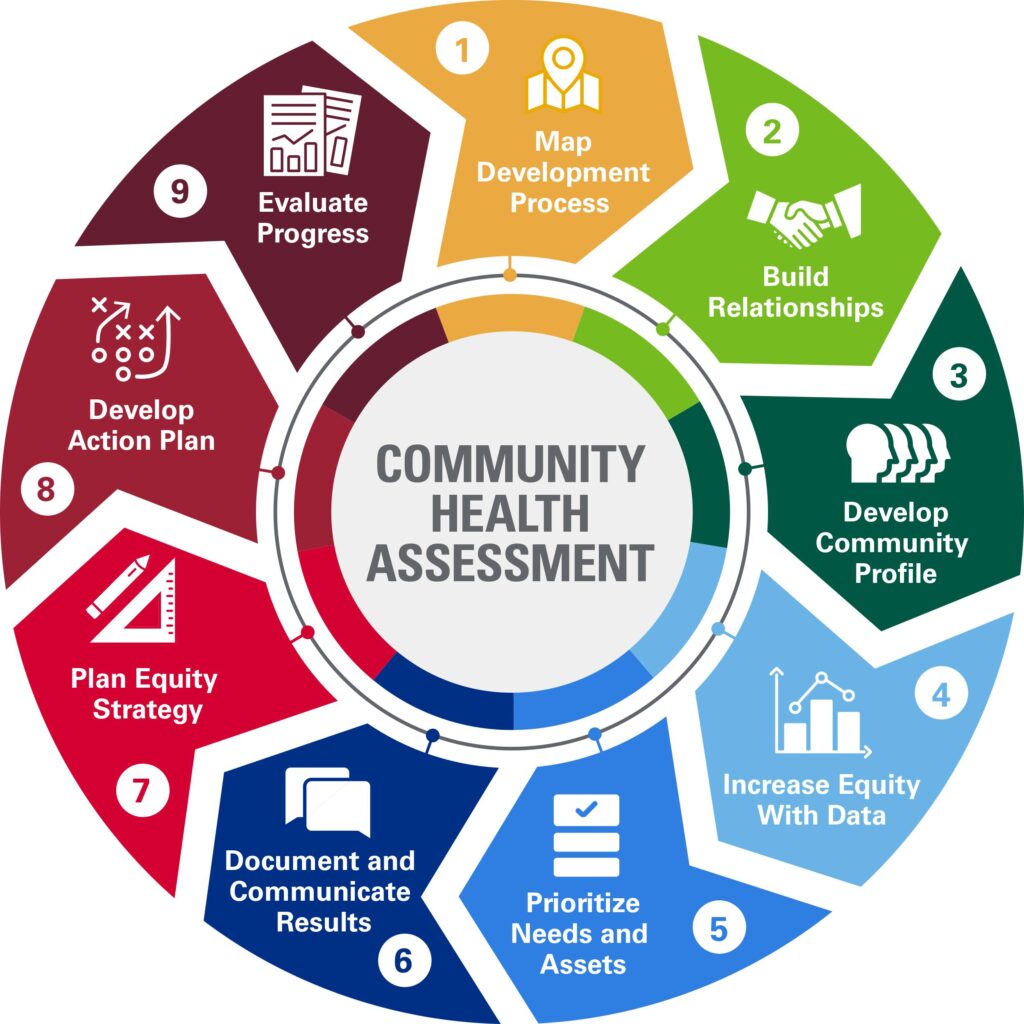Introduction
A Community Health Improvement Plan (CHIP) is a crucial blueprint designed to enhance the overall health and well-being of a community. It is a long-term, systematic effort aimed at addressing public health issues based on the results of community health assessments. This plan not only aims to improve health outcomes but also seeks to foster a collaborative environment where various stakeholders work together to achieve common health objectives.
The Importance of a Community Health Improvement Plan
A CHIP is essential because it provides a structured approach to identifying and addressing the most pressing health needs of a community. By leveraging data from community health assessments, stakeholders can prioritize health issues, allocate resources efficiently, and implement evidence-based interventions. This targeted approach helps in reducing health disparities and promoting health equity.
Steps to Develop a Community Health Improvement Plan
1. Conduct a Comprehensive Community Health Assessment
The first step in developing a CHIP is to conduct a thorough Community Health Assessment (CHA). This involves collecting and analyzing data on the health status, needs, and resources of the community. Key components of a CHA include:
- Data Collection: Gathering quantitative data (e.g., morbidity and mortality rates) and qualitative data (e.g., community surveys and focus groups).
- Data Analysis: Identifying health trends, disparities, and determinants of health.
- Community Involvement: Engaging community members to ensure their perspectives and experiences are considered.
2. Identify and Prioritize Health Issues
Once the assessment is complete, the next step is to identify and prioritize the community’s health issues. This process involves:
- Data Interpretation: Analyzing the collected data to pinpoint critical health concerns.
- Stakeholder Engagement: Collaborating with local health departments, healthcare providers, and community organizations to validate and prioritize health issues.
- Setting Priorities: Using criteria such as the magnitude of the problem, the severity of health outcomes, and the feasibility of interventions to rank health issues.
3. Develop Goals, Objectives, and Strategies
With prioritized health issues in hand, the next step is to develop clear goals, objectives, and strategies to address them. This includes:
- Setting Goals: Defining broad, long-term health improvement targets.
- Establishing Objectives: Creating specific, measurable, achievable, relevant, and time-bound (SMART) objectives.
- Formulating Strategies: Identifying evidence-based interventions and actions to achieve the objectives.
4. Implement the Plan
Implementation is a critical phase where the strategies are put into action. Key components include:
- Action Plans: Developing detailed action plans outlining the steps, resources, timelines, and responsible parties for each strategy.
- Resource Allocation: Ensuring adequate funding, personnel, and materials are available to support implementation.
- Community Engagement: Continuously involving community members and stakeholders to foster ownership and participation.
5. Monitor and Evaluate Progress
Monitoring and evaluation are essential to track progress and make necessary adjustments. This involves:
- Performance Monitoring: Regularly assessing the implementation process and outcomes.
- Outcome Evaluation: Measuring the impact of the interventions on the community’s health.
- Continuous Improvement: Using evaluation findings to refine and improve the plan.

Key Components of a Successful Community Health Improvement Plan
Collaboration and Partnership
Successful CHIPs rely on strong collaboration and partnerships among various stakeholders, including:
- Public Health Agencies: Leading the assessment, planning, and implementation processes.
- Healthcare Providers: Offering insights into health trends and contributing to intervention efforts.
- Community Organizations: Providing valuable community perspectives and support.
- Residents: Engaging actively in the planning and implementation phases to ensure the plan reflects their needs and preferences.
Data-Driven Decision Making
Effective CHIPs are grounded in robust data. This includes:
- Health Data: Utilizing health statistics to identify and prioritize issues.
- Social Determinants of Health: Considering factors such as socioeconomic status, education, and environment that influence health outcomes.
- Community Input: Integrating feedback from community members to ensure the plan is relevant and comprehensive.
Sustainability
Ensuring the sustainability of health improvements is a key goal of any CHIP. This involves:
- Building Capacity: Strengthening local infrastructure and workforce to support ongoing health initiatives.
- Securing Funding: Identifying and securing diverse funding sources to sustain interventions.
- Policy Development: Advocating for policies that promote and sustain health improvements.
Case Studies: Successful Community Health Improvement Plans
Case Study 1: Reducing Childhood Obesity
A community identified childhood obesity as a critical health issue. The CHIP focused on:
- Nutrition Education: Implementing school-based nutrition programs and community workshops.
- Physical Activity: Creating safe, accessible spaces for physical activity, such as parks and recreational facilities.
- Policy Changes: Advocating for healthier school meal policies and restrictions on sugary drinks.
Case Study 2: Addressing Mental Health
In response to rising mental health concerns, another community developed a CHIP that included:
- Access to Care: Expanding mental health services and reducing barriers to access.
- Awareness Campaigns: Launching public awareness campaigns to reduce stigma and promote mental health resources.
- Support Systems: Establishing peer support groups and training community members in mental health first aid.
Conclusion
A Community Health Improvement Plan is a vital tool for addressing the health needs of a community in a structured and collaborative manner. By following a systematic process of assessment, prioritization, planning, implementation, and evaluation, communities can make significant strides in improving health outcomes. The success of a CHIP hinges on robust data, strong partnerships, and a commitment to sustainability. Through effective CHIPs, communities can achieve healthier, more equitable environments for all residents.




Hey people!!!!!
Good mood and good luck to everyone!!!!!
What are the benefits of having pets, the advantages of pets.
what to consider when choosing a pet, popular pet breeds.how to ensure comfort and care for pets, how to create a pet’s diet.Interesting facts about pets, how pets influence us.effective methods of pet training, how to train a cat to walk on a leash.
anatomy of domestic animals anatomy of domestic animals .